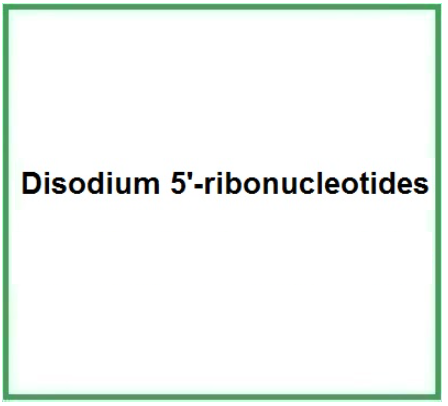Disodium 5'-ribonucleotides or E635, is a chemical compound that is produced by enzymatic hydrolysis of RNA by 5′-phosphodiesterase from yeast. Ribonucleotides are substances normally present in all human tissues.
It is a food additive primarily used as a flavor enhancer. It is a mixture of two nucleotides: disodium 5'-inosinate and disodium 5'-guanylate. E635 is commonly used to improve the taste of processed foods by amplifying the umami flavor and intensifying the overall flavor perception. It is often found in products such as savory snacks, instant soups, sauces, and ready-to-eat meals.
Chemical Composition and Structure
E635 is composed of two nucleotides: disodium 5'-inosinate (a derivative of inosinic acid) and disodium 5'-guanylate (a derivative of guanylic acid). These two compounds work synergistically with monosodium glutamate (MSG) to enhance the umami taste of foods, giving them a richer and more savory flavor profile.
The name defines the structure of the molecule:
- "Disodium" indicates that the molecule contains two sodium atoms. These are typically present as counterions to balance the molecule’s charge.
- "5'-ribonucleotides" refers to a type of nucleotide, the constituent elements of RNA. The "5'" indicates that the nucleotide is connected by the 5' carbon of the sugar ring.
Production Process
Disodium 5'-ribonucleotides are produced through the fermentation of natural substances such as sugars or starch, using selected bacteria. Once inosinic acid and guanylic acid are produced, they are converted into their disodium forms for use as a food additive.
Extraction of Nucleic Acids: Nucleic acids can be extracted from plant or animal sources such as yeast, algae, or meat. This process may involve cell lysis and the use of aqueous solutions to isolate the nucleotides.
Hydrolysis of Nucleic Acids: The extracted nucleic acids are subjected to enzymatic or chemical hydrolysis, breaking them down into nucleotides. Enzymes such as nucleases can be used to facilitate this process.
Neutralization: Once the nucleotides are obtained, they are neutralized with a sodium solution to produce disodium salts. This step is essential to convert the nucleotides into disodium 5'-ribonucleotides.
Purification: The produced disodium 5'-ribonucleotides are purified to remove any impurities and chemical residues. This may include filtration and crystallization processes to ensure a high-quality product.
Quality Control and Packaging: Finally, disodium 5'-ribonucleotides undergo quality control checks to verify their purity and functional properties. After analysis, they are packaged for distribution and use in food products.
Physical Properties
E635 typically appears as a white or crystalline powder that is water-soluble. It is odorless and tasteless on its own, but when added to foods, it significantly enhances the savory and umami flavors. It is highly effective even in small amounts, making it a valuable additive in various food formulations.

Food
Ingredient included in the list of European food additives as E635 with the function of a flavour enhancer, i.e. to artificially increase the taste of a product. It is mainly included in products containing monosodium glutamate.
EFSA's Food Additives Panel considered that, in the absence of information on the microbial strains or substrates used to produce the additives, and with little information on the production process, it is not possible to determine whether the production process introduces safety concerns (1).
Allergic Reactions
Specific allergic reactions to E635 are rare. However, individuals who are sensitive to monosodium glutamate may wish to avoid combining E635 with MSG, as both can enhance the umami effect and, in rare cases, cause symptoms in sensitive individuals.
References_____________________________________________________________________
(1) EFSA Panel on Additives and Products or Substances used in Animal Feed (FEEDAP), 2014. Scientific Opinion on the safety and efficacy of disodium 5′‐ribonucleotides, disodium 5′‐guanylate, disodium 5′‐inosinate for all animal species and categories. EFSA Journal, 12(3), p.3606.
Abstract. The flavours included in this assessment are widely present in nature as the building blocks of DNA and RNA. In the absence of any information on the microbial strains or substrates used for the production of the additives, and with little information on the manufacturing process, the FEEDAP Panel is unable to ascertain whether the manufacturing process introduces any safety concerns. Disodium 5′-guanylate and disodium 5′-inosinate and their mixture are considered to be safe for the target animals and the consumer. However, considering the lack of information on the production process, these conclusions apply only to the compounds ‘per se’ and their extrapolation to any feed additive containing these compounds is not possible. In the absence of any data related to hazard to the user, it would be prudent to regard disodium 5’-guanylate and disodium 5′-inosinate and their mixture as potentially hazardous to workers by skin or inhalation exposure. The compounds under assessment are naturally present in feed materials; therefore, no risk to the safety for the environment is foreseen. Since these compounds are used in food as flavourings, and their function in feed is essentially the same as that in food, no further demonstration of efficacy is necessary.
![]() Sodium 5'-ribonucleotides
Sodium 5'-ribonucleotides 


